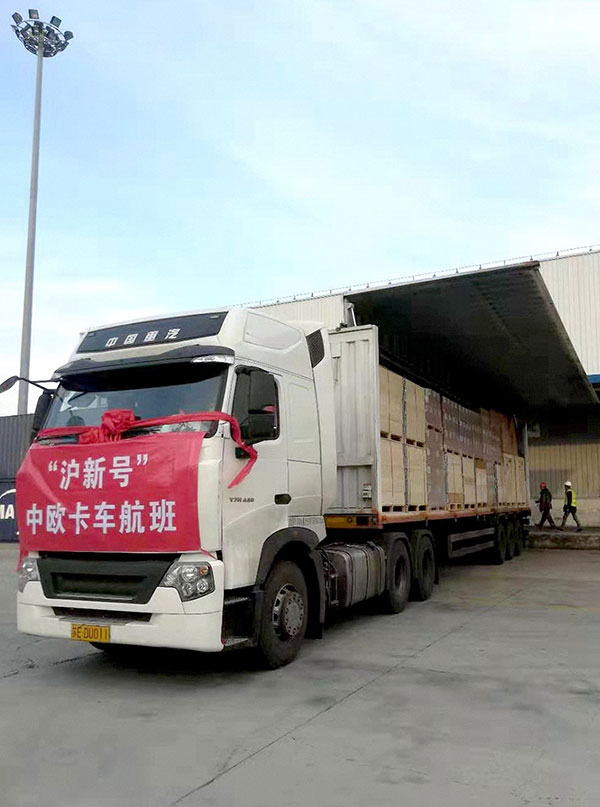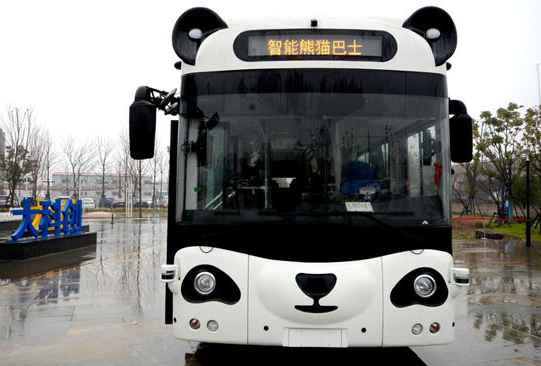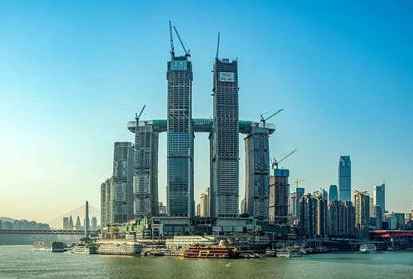


A truck loaded with high-tech equipment from Germany being unloaded in Shanghai on Saturday. [Photo provided to China Daily]
Flexibility, cost advantage and ability to handle large volumes boosting demand
Truck freight between China and Europe is set to increase substantially after a vehicle loaded with high-tech manufacturing equipment successfully completed the 11,000 kilometer road journey from Dornstadt in Germany to Shanghai in two weeks.
The freight-laden truck crossed Germany, Poland, Belarus, Russia and Kazakhstan before entering China for the final leg of its journey. It was also the first Europe-to-Shanghai truck freight by Suzhou-based logistics company, Suzhou Daoxin Supply Chain Management Co Ltd.
In February, Shanghai Lishun Electronics Science &Technology Co Ltd co-founder Xiong Desen's international trade company received an order for these equipment from a German company in Minhang district. But due to adverse weather conditions, the company could not use airfreight to ship the products in two weeks.
"When we learned that the goods could be transported through the roads in two weeks, we immediately decided to use this option," said Xiong. The truck carrying the hightech equipment completed customs clearance at Khorgas in the Xinjiang Uygur autonomous region, and reached Shanghai as per schedule.
"I never thought that the customs clearance would take only two to three hours. This is much shorter when compared with our previous experience of at least two to three days," said Xiong.
According to him, although air travel is faster, the freight spends more time in customs clearance and transitions. "In addition, we saved delivery costs by 42 percent through the road transport. So we are going to use truck transportation as much as possible in the future," said Xiong. Up to 90 percent of the company's goods were shipped by air before, as the products are of high value and delicate.
Another reason for using air transport was the strict security and time constraints. Rail transport was not feasible as it involved having a full train laden with goods to make it economically viable. In addition, goods had to be despatched to the railway station first, followed by road transit of the goods to the final destination, said Xiong.
According to IRU estimates, road transport can save up to 10 days compared to rail, and it costs much less than air transport.
Hu Rongyi, general manager of Suzhou Daoxin, was one of the earliest people to spot the opportunities in road transportation between Europe and China.
According to Hu, the logistics company focusing on cross-border transportation has seen a rising demand for trade between China and countries and regions related to the Belt and Road Initiative in the past few years.
After paying some visits by staff members along the truck route, Suzhou Daoxin delivered its first batch of goods, a truck of steel rolls from Germany's Stuttgart to Suzhou in Jiangsu province in March 2018. However, the pilot transport was unsatisfying as it took 21 days.
"We made a few more trials, and finally managed to get the goods delivered in 12 and 13 days late last August," said Hu. Currently, Suzhou Daoxin operates truck transport services between Europe and Chinese cities every week.
After running the transport service for more than six months, Hu said there are still many things to be done to optimize the 10,000 km trip, especially in terms of infrastructure.
"My hope is to have more companies joining in the game, because the more investment put into this sector, the better we can do for the whole industry," said Hu.
Alblas Transport (Xinjiang) Co Ltd is another company that operates road transport services across Eurasia. Currently a truckload of goods from Foshan in Guangzhou province is on its way to Alicante in Spain.
"I expect it will take about 18 days to complete the 13,500 km route, and the alternative transportation method has received a favorable response from our clients," said Dilxat Mamat, chief operating officer of Alblas Transport (Xinjiang).
The Foshan to Spain delivery marks the launch of Alblas truck transport services from China to Europe on a weekly basis after two successful trials last November and in February.
"Road transport costs are less than 30 percent that of air, and it also saves transition required between airports and the final destination," said Mamat.
The strength of truck transportation is obvious when compared with marine transport, as the latter usually lasts between 45 days and two months (depending on weather conditions), and the goods need to get onboard and off-board four or five times due to necessary transitions, said Xiong.
"Under the TIR Convention, we can realize door-to-door transport, without having to open the containers for checking. This is also the advantage of TIR road transport," he said.
TIR, or Transports Internationaux Routiers, is the only global customs transit system for moving goods across international borders. Since its inception in 1948, it has been promoting the facilitation of international road transport and driving the development of trade. Having 76 contracting parties, TIR is governed by the United Nations TIR Convention and managed by Switzerland-based IRU (International Road Transportation Union). China has been a TIR member since 2016.
"In terms of efficiency, road transport saves up to 50 percent costs compared to air, and at least 10 days delivery time compared with rail. The high flexibility of road transport can ensure 'door-to-door' services, which is suitable for high-priced goods and clients with strict time requirements. In addition, it can also solve the problem of bulk cargo shipment," said Zhou Yan, deputy chief representative, East and Southeast Asia, IRU.
According to Zhou, there is great potential for road transport across Eurasia. First, the European Union is the largest trade partner and largest source of imports for China, and under the Belt and Road Initiative, the bilateral trade volume has been increasing steadily.
In 2018, China's total trade volume to the EU amounted to 4.5 trillion yuan ($669.1 billion), up 7.9 percent year-on-year, according to data from the General Administration of Customs.
In addition, major markets along the Silk Road Economic Belt and all EU countries are TIR members. With the implementation and optimization of TIR in China, road transport as a cross border tool will play a greater role in trade flows.
"Under the current international situation, the Belt and Road Initiative has gained more influence. As trade volume between China and Europe is huge, truck transport offers an alternative option besides air, sea and rail. It will also bring more development opportunities in countries and regions related to the Belt and Road Initiative," said Zhou.

 Over 80 million people lifted out of poverty in China in past six years
Over 80 million people lifted out of poverty in China in past six years The grandmothers in power in China's “Kingdom of Women”
The grandmothers in power in China's “Kingdom of Women” Aviation science enters rural school in central China
Aviation science enters rural school in central China China to further boost AI competitiveness
China to further boost AI competitiveness More areas in China open to wholly foreign-owned enterprises
More areas in China open to wholly foreign-owned enterprises Xinjiang instrument maker dedicated to passing on skills to next generation
Xinjiang instrument maker dedicated to passing on skills to next generation China to see more smart restaurants
China to see more smart restaurants China to launch lunar probe Chang’e-5 in 2019, Mars probe in 2020
China to launch lunar probe Chang’e-5 in 2019, Mars probe in 2020 China’s architecture miracles add glamour to world records
China’s architecture miracles add glamour to world records Giant panda pattern seen in SW China rapeseed fields
Giant panda pattern seen in SW China rapeseed fields